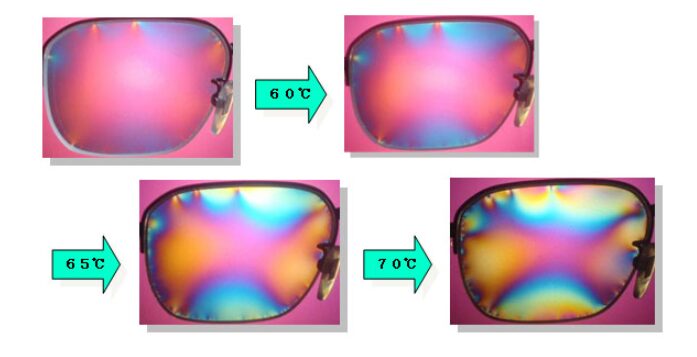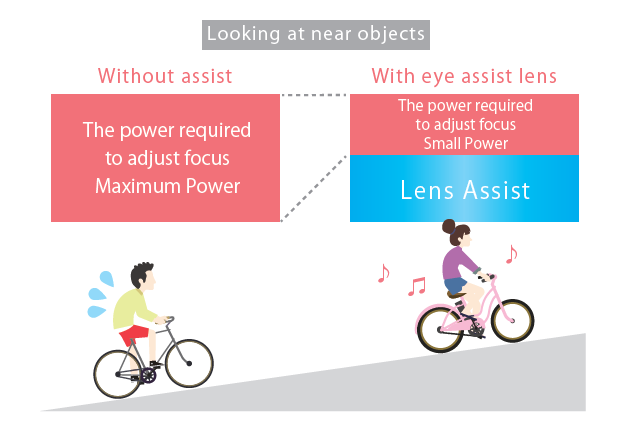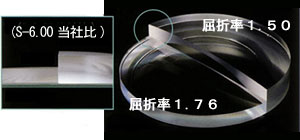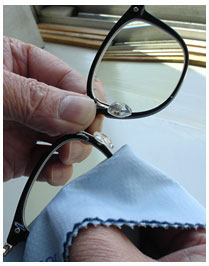This time, we would like to give you some advice on how to deal with troubles regarding “looks and impressions to others” through eyeglasses, such as the thickness of lenses and the size of the eyes.
The powers of my lenses are as follows:
R: S-10.00
L: S-9.00
Let us start with the mechanism of how the eyes appear to be small, which is a little difficult to understand.
First of all, an eyeglass lens is an “aggregate of prisms.”
A prism is a triangular as shown in Figure 1, and the pointed side is called a ridge, and the bottom side is called a base.
A lens for myopia (- lens, concave lens) is the thinnest in the center and gradually increases in thickness toward the edge.
That is, it has a shape whose ridge extends toward the center of the lens (Figure 2).
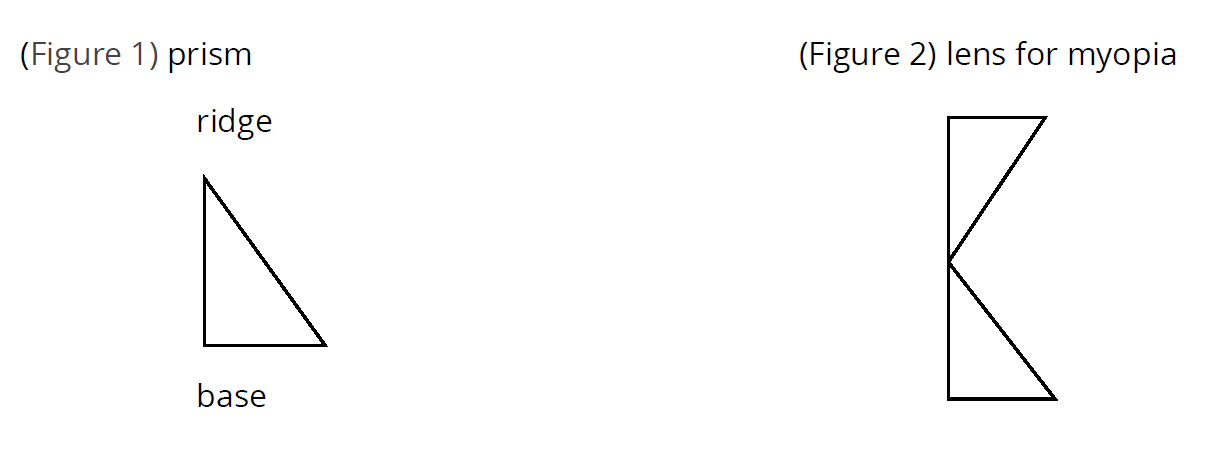
We think there are many people who have a similar trouble.
We would like to get directly to the conclusion.
Slight improvement can be achieved, although depending on the type of the eyeglass lenses you are currently wearing, but the change of the lenses alone is insufficient.

One of the characteristics of a prism is the nature that “the image is drawn toward the ridge” when an object is seen through it.
This means that the image of an object seen through a lens for myopia is “contracted” = appearing to be smaller than normal as it is drawn toward the center.
In addition, when an eye is seen by someone through an eyeglass lens, it appears to be smaller than normal.
It may be a little difficult to understand. So, imagine a “magnifying glass.”
It is thick in the center and gradually decreases in thickness toward the edge.
This state is totally opposite to a lens for myopia.
In other words, when the abovementioned nature is applied, the image of an object seen through a magnifying glass is “enlarged” = appearing to be larger than normal as it is drawn outward.
Keeping the abovementioned states in mind, let us take a look at the state when a person with severe myopia wears eyeglasses.
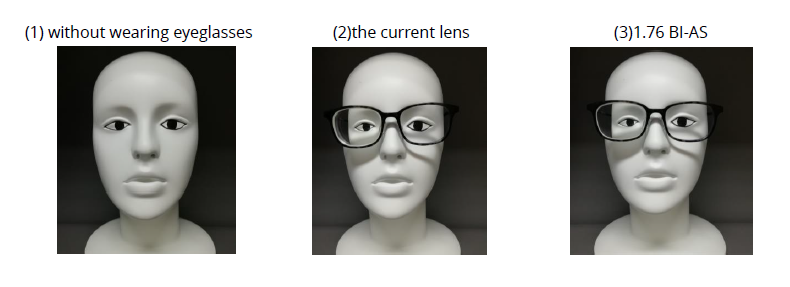
(1) is a photo showing the state without wearing eyeglasses, (2) is a photo showing the state of setting the current lens for the right eye (assuming a lens with an index of 1.60 this time), and (3) is a photo showing the state of setting a “1.76 BI-AS” (index: 1.76) for the right eye.
*For the purpose of comparison, no lens is set for the left eye.
When (1) and (2) are compared, the eye appears to be considerably smaller than the naked eye as you see, and the contour of the face is also contracted greatly.
Then, what if the lens is changed to “1.76 BI-AS,” which the customer inquired (2 → 3 in the photo)?
Unfortunately, little change can be observed.
We actually measured the width of the eye over the lens, and value was 18 mm in (2), whereas it was 19 mm in (3). It can be said that the lens brought about a slight effect in the value, but it was not a visually identifiable level.
The factors that affect the contraction rates (enlargement rates) of the eyes and the contour of the face include thickness, index, surface curve, vertex distance, and so on.
By changing the lens to a “thin lens with a high index” as in the present case, a good effect will be obtained in theory in connection with the thickness and the index.
Note, however, that it is extremely difficult to obtain visible effects unless something extraordinary occurs.
With regard to the surface curve, a milder curve can suppress the contraction rate (enlargement rate), but a satisfactory effect is not obtained from it.
*) Surface curve: Indicates the degree of the curvature of the lens surface.
When it comes to another factor, vertex distance, it exerts a relatively greater effect than the abovementioned factors.
*) Vertex distance: Indicates, in a word, the distance from the eye to the lens.
Take a look at the photos below.
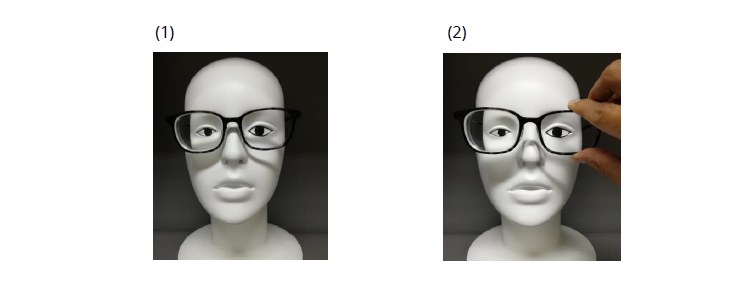
Don’t you think that the image of (2) is smaller than that of (1)?
The photo of (1) was taken with a vertex distance, general average of 12 mm, and the photo of (2) was taken a vertex distance set farther by 10 mm.
An extreme example was cited to help you understand the difference easily. Reducing this distance, even if only slightly, can be another approach to suppressing the contraction rate (enlargement rate).
However, it is necessary to consider the balance with the shape of the face, the length of eyelashes, etc.
We have told you about eyeglass lenses and fitting thus far, but to tell the truth, there is something more important than lenses when you take care of your impressions to other.
That is the “selection of a frame.”
Take a look at the photos below.
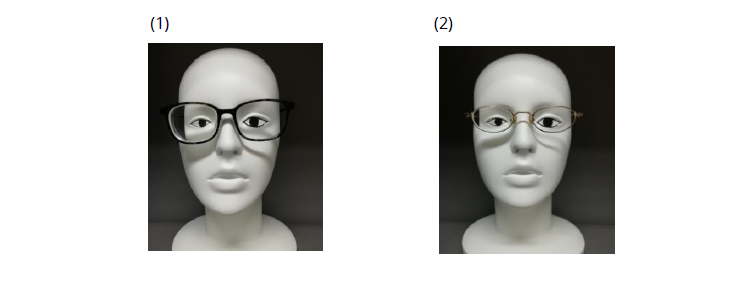
Don’t you feel that the contraction of the image of (2) is somewhat suppressed compared to (1)?
This can be said to be a kind of “optical illusion effect.”
[Delboeuf illusion]
Even a circle of the same size looks small in a large circle (left) but looks large in a small circle.
Only frames were changed with all conditions, including the type of the lens, power, and vertex distance, unchanged.
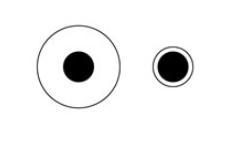
Only frames were changed with all conditions, including the type of the lens, power, and vertex distance, unchanged.
- Frame of (1)
Lens width: 52 mm, nose width: 17 mm, vertical width: 37 mm - Frame of (2)
Lens width: 46 mm, nose width: 20 mm, vertical width: 24 mm
Both of the lens width (lateral width of the lens) and the vertical width (vertical width of the lens) of (2) are considerably reduced.
You can feel that the distortion of the contour of the face becomes less noticeable, in addition to the size of the eyes by illusion, by selecting a frame fit for the size of the face.
Different from the selection of lenses, the selection of a frame is greatly affected by the taste of the customer, and we are concerned about “what should be given priority.”
You have read this article thus far, and some of you may think: “Then, don’t I bother to select ultra-thin, high-grade lens?”
Surely, the effect of suppressing the contraction rate (enlargement rate) may be less than expected.
However, the biggest effect of lenses with a high index is “thinness.”
The photo below shows lenses with the same index set in the frame of (1) shown above.
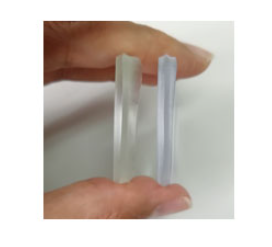
The left lens has an index of 1.60, and the right lens has an index of 1.76.
The thickest parts are 8.0 mm and 6.8 mm, the difference between which is as much as 1.2 mm. The value is not large, but the difference is obvious at a glance.
Take a look at the ear sides of (2) and (3) of the three photos shown at the top of the article. The ear side of (2) looks a little white.
This is the so-called “milk bottle bottom”-like phenomenon.
Compared to this, you can see that the photo of (3) is considerably clean-cut.
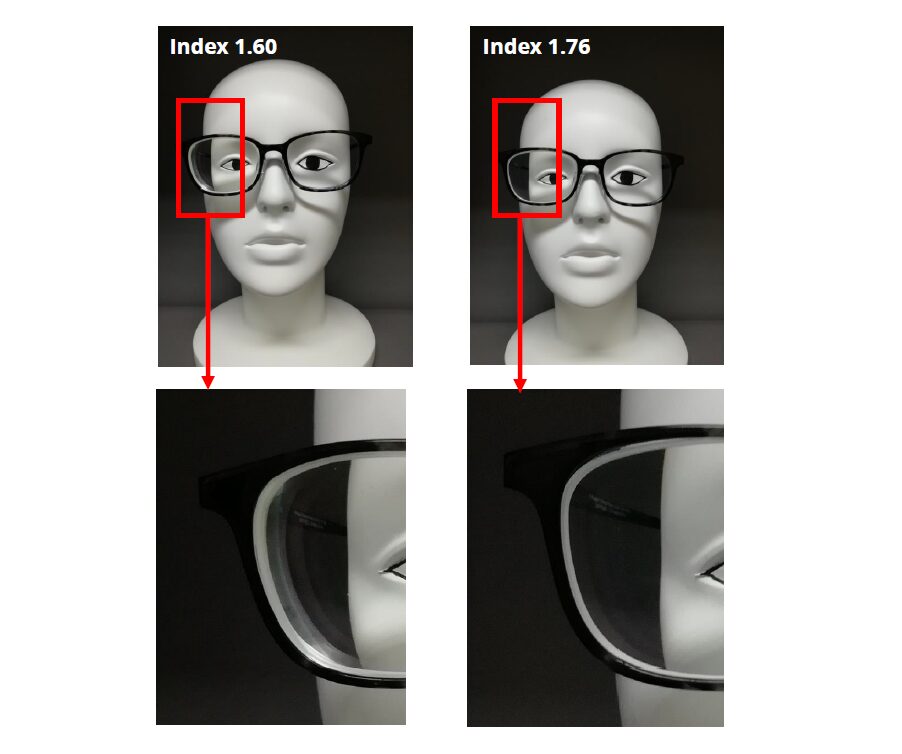
In addition, the weight of the lens with an index of 1.60 is 7.80 g, whereas that of the lens with an index of 1.76 is 7.04 g.
The value of the difference also looks slight, but this difference must be significant to those who have worn thick, heavy eyeglasses.
We believe that customers with severe myopia have so many troubles.
As a lens manufacturer, it would be very pleased to help them with our eyeglass lenses, but many of the troubles cannot be resolved by lenses alone.
We recommend that you should closely consult an eyeglass store to find the best solution, including the selection of a frame and fitting as part of “eyeglasses.”
In addition, it is difficult to determine which information should be selected or referred to, but people having the same troubles upload methods for selecting frames and makeup skills on the Internet.
Please refer to such information.


